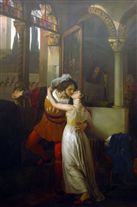RomeoJulietRoom4cfd2bd90fe92.jpg
Romeo and Juliet's Room - Click 'Details' for more information
ROMEO AND JULIET'S ROOM:
In this room are located some of the most important paintings of the museum. The last Adieu of Romeo and Juliet, 1823, oil on canvas by Francesco Hayez (1791-1882) is a manifesto of the Italian Romantic painting. Inspired by the famous Shakespearean tragedy, this painting was commissioned by Sommariva in 1823. The scene - in the house of Juliet, the young woman is embracing Romeo for a last kiss in the pink light of dawn - is characterised by an interesting structure and the chromatic expression inspired by the ancient Venetian tradition of coloration. This is followed by the painting The Spicery of a cloister, 1823, oil on canvas by Giovanni Migliara (1785-1837). In a court, some friars are working to prepare potions and medicaments: it's an extraordinary scene, very rich in details, such as the frescos on the vaults, the cat moving between the pots, the smoke of the alembics, the window in the background, open to another court with green trees.
The third painting in this room is Atala's last communion, by Pierre-Jérome Lordon (1780-1838) done in 1808 and exhibited the same year in the Parisian salon of arts. It's a very involving scene, with strong lights contrasts and romantic awesomeness. The subject is taken from the epilogue of Atala, Chateaubriand's novel: the dying heroine, helped by her lover Chactas is receiving the Holy Communion from father Aubry. In this room are also located two extraordinary vases in Sèvres porcelain, with a dark blue enamelled background decorated in pure gold and two sculptures, the Sensibility, a very rare plaster model by the French Antoine-Denis Chaudet (1763-1810) and Eros provides two doves with drink, 1821, by Luigi Bienhaimé (1795-1878).
